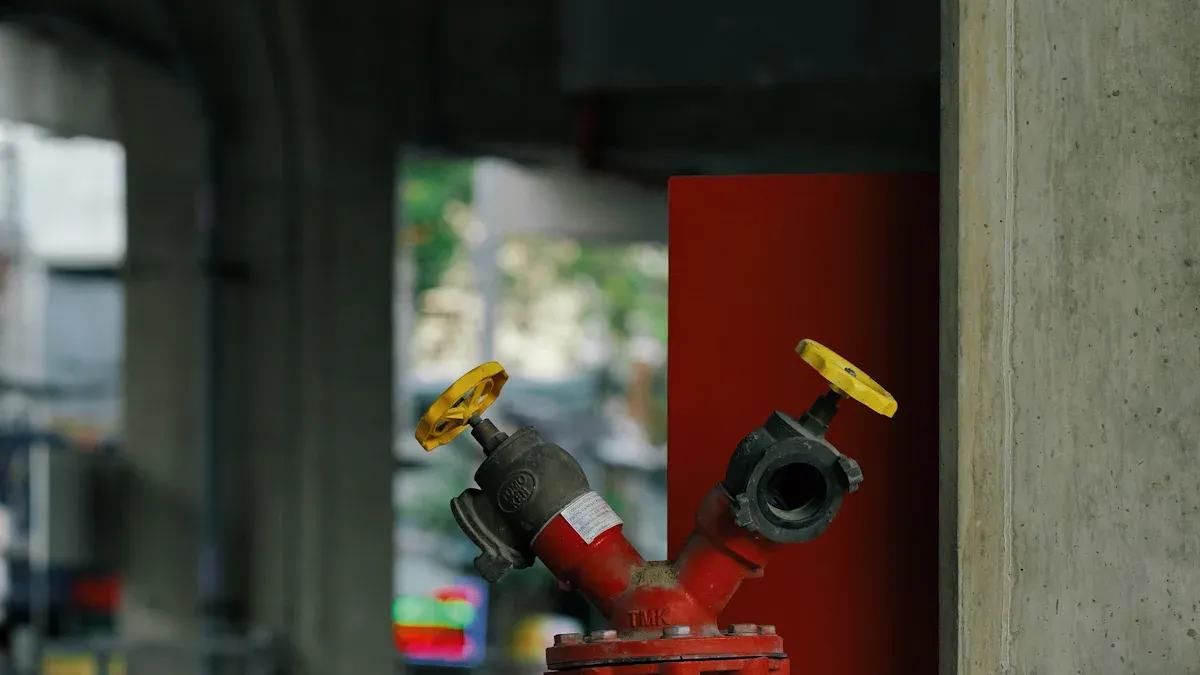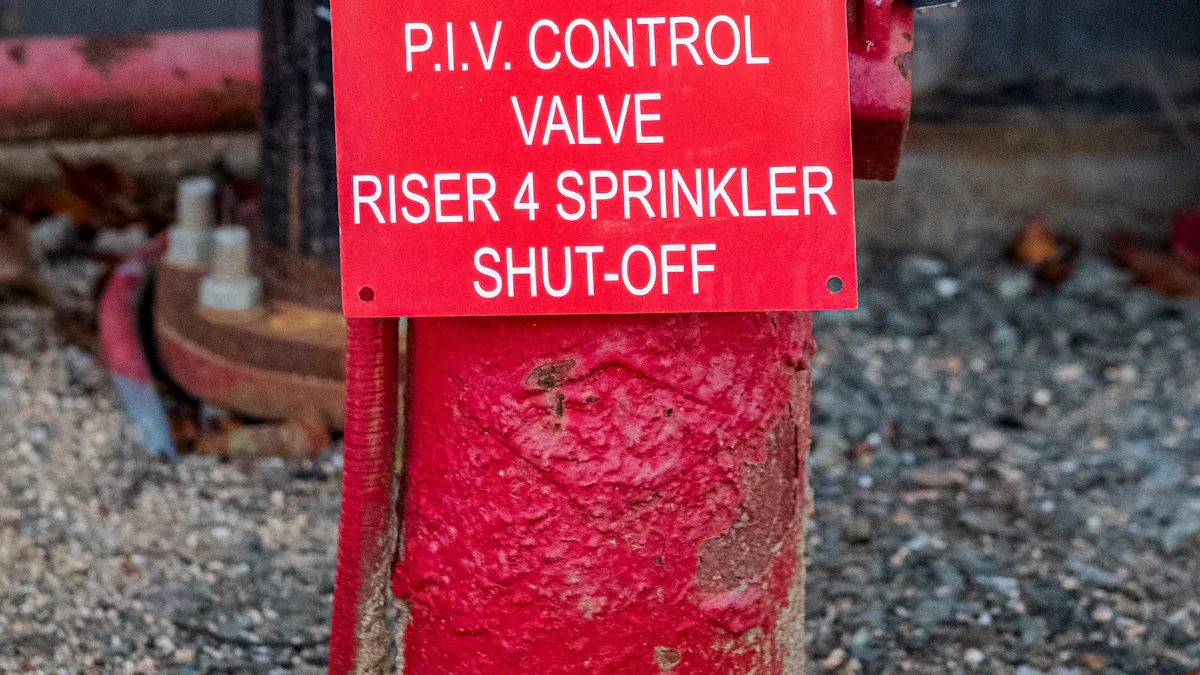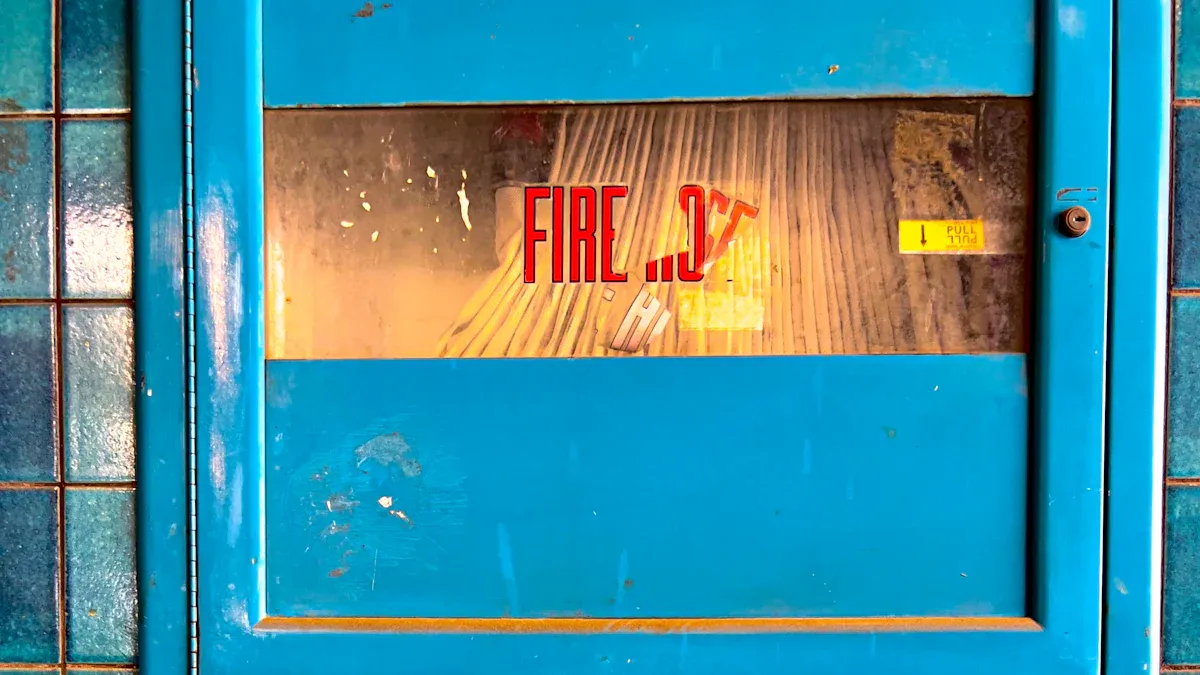
Selecting the right valve plays a crucial role in ensuring optimal fire safety. The Right Angle Valve and Oblique Valve differ in their design and functionality, making them suitable for different systems. For instance, installation requirements often dictate the placement and type of valve, including the Straight Valve and Landing Valve. Post indicator valves, as outlined by NFPA 14, must be positioned at least 40 feet from buildings unless exceptions apply. Moreover, their posts should stand 32 to 40 inches above the final grade. Maintenance preferences also vary, as each valve type, including the Fire Hydrant Valve, influences accessibility and serviceability. Understanding these distinctions helps in making informed decisions tailored to specific fire safety setups.
Key Takeaways
- Right angle valves work well in small fire safety systems. They control water flow efficiently in tight spaces.
- Oblique valves improve water flow and lower pressure loss. They are great for systems with long pipes.
- Think about your system’s design and needs when choosing a valve. Right angle valves handle high pressure, while oblique valves manage flow better.
- Keeping valves in good shape is very important. Make sure they are easy to check and maintain.
- Price matters too. Right angle valves usually cost less, but oblique valves can save money over time with less upkeep.
Understanding Right Angle Valves

Key Features of Right Angle Valves
Right angle valves are essential components in fire safety systems, designed to control water flow efficiently. Their unique 90-degree angle design allows for compact installation, making them ideal for tight spaces. These valves are built to meet stringent industry standards, ensuring reliability and performance.
| Standard | Description |
|---|---|
| ASME B16.34 | Establishes pressure classes for valves, determining maximum allowable working pressures at given temperatures. |
| MSS SP-80 | Provides requirements for brass valves used in general-purpose services. |
| MSS SP-85 | Governs materials and dimensions for gray iron valves, including angle valves. |
| NFPA 14 | Requires angle valves for hose connections to be listed and have National Hose Standard threads. |
| NFPA 14 (Pressure-Reducing) | Allows pressure-reducing hose angle valves to regulate pressure in multi-story buildings. |
Additionally, standards like ANSI/ISA-75.08.08-2015 ensure uniformity in face-to-centerline dimensions, simplifying integration into piping systems. ANSI/ISA-75.11.01-2013 provides guidance on evaluating flow characteristics, aiding in the selection of the right valve for specific applications.
Pros and Cons of Right Angle Valves
Right angle valves offer several advantages:
- Compact design optimizes space in fire safety systems.
- Easy to install and maintain due to their straightforward structure.
- Compliant with multiple industry standards, ensuring safety and reliability.
Tip: Regular maintenance enhances the lifespan and performance of right angle valves.
However, their suitability depends on the system’s design and pressure requirements. Consulting a trusted manufacturer like Yuyao World Fire Fighting Equipment Factory ensures the right choice for your needs.
Best Use Cases for Right Angle Valves
Right angle valves excel in systems where space is limited or where a 90-degree turn in water flow is necessary. They are commonly used in:
- High-rise buildings requiring pressure regulation.
- Compact fire sprinkler systems.
- Industrial facilities with complex piping layouts.
Their ability to handle high-pressure environments makes them a preferred choice for demanding fire safety applications.
Exploring Oblique Valves

Key Features of Oblique Valves
Oblique valves, also known as radial diaphragm valves, are designed to optimize flow efficiency and reduce pressure loss. Their unique body design positions the inlet and outlet ports diagonally, creating a more direct flow path. This configuration minimizes turbulence and enhances performance in fire safety systems.
| Feature | Description |
|---|---|
| Body Design | Inlet and outlet ports are oriented diagonally, providing a more direct flow path. |
| Advantages | Moderately lower pressure drop compared to Z-body valves; effective for flow regulation. |
| Disadvantages | Less common and not as widely available or standardized as other globe valve designs. |
The advanced design of oblique valves also incorporates solid PTFE diaphragms, which allow for higher sterilization temperatures. This feature extends the intervals between diaphragm replacements, reducing maintenance costs and improving system availability.
Pros and Cons of Oblique Valves
Oblique valves offer several technical advantages that make them a valuable choice for fire safety systems:
- Enhanced Drainability: The line seal is positioned at the outside of the valve, improving cleaning and sterilization efficiency.
- Reduced Pressure Drop: The diagonal flow path minimizes resistance, ensuring smoother water flow.
- Durability: Solid PTFE diaphragms withstand high temperatures, increasing the valve’s lifespan.
Note: Unlike right angle valves, oblique valves eliminate dead legs in piping systems, which can harbor contaminants in certain applications.
However, oblique valves are less common and may not be as widely available as other valve types. Consulting a trusted supplier like Yuyao World Fire Fighting Equipment Factory ensures access to high-quality oblique valves tailored to specific needs.
Best Use Cases for Oblique Valves
Oblique valves are ideal for fire safety systems requiring efficient flow regulation and minimal pressure loss. They are particularly suited for:
- Systems with long piping runs where pressure drop must be minimized.
- Facilities prioritizing high sterilization standards, such as hospitals or laboratories.
- Applications where frequent cleaning or maintenance is necessary.
Their advanced design and performance characteristics make oblique valves a reliable choice for demanding fire safety environments. Yuyao World Fire Fighting Equipment Factory provides expertly crafted oblique valves to meet these requirements, ensuring safety and efficiency in every application.
Comparing Right Angle Valves and Oblique Valves
Performance in Fire Safety Systems
Performance plays a critical role in determining the suitability of a valve for fire safety systems. Right angle valves excel in compact systems where space constraints demand efficient water flow control. Their 90-degree design ensures precise flow regulation, making them ideal for high-pressure environments. These valves meet industry standards, including NFPA 14, which guarantees their reliability in demanding applications.
Oblique valves, on the other hand, prioritize flow efficiency. Their diagonal design minimizes turbulence and reduces pressure loss, ensuring smoother water delivery. This feature makes them particularly effective in systems with long piping runs or applications requiring consistent flow rates. Facilities such as hospitals and laboratories benefit from oblique valves due to their ability to maintain high sterilization standards while delivering optimal performance.
Both valve types offer unique advantages. Right angle valves provide compactness and precision, while oblique valves enhance flow efficiency and reduce pressure drop. Selecting the appropriate valve depends on the specific requirements of the fire safety system.
Installation and Maintenance Considerations
Ease of installation and maintenance significantly impacts the long-term performance of fire safety valves. Right angle valves are straightforward to install due to their compact design. Their simple structure allows for quick alignment and integration into piping systems, reducing installation time. Maintenance is equally convenient, as their accessibility simplifies routine inspections and repairs.
Oblique valves require careful positioning to maximize their flow efficiency. Proper alignment during installation prevents leaks and wear, ensuring long-term reliability. Accessibility is crucial for maintenance, as obstructions can hinder inspections and repairs. Regular checks for corrosion, wear, and actuator performance are essential to maintain their functionality.
| Evidence | Description |
|---|---|
| Proper Alignment | Misalignment during installation can lead to leaks, wear, and even valve failure over time. Use alignment tools for precision. |
| Accessibility | Install valves in locations that allow for easy access during maintenance. Consider the positioning of adjacent components to avoid obstructions. |
| Regular Inspections | Conduct routine checks for leaks, wear, and corrosion. Inspect actuator performance to ensure responsive and accurate operation. |
| Maintenance Records | Maintain accurate and up-to-date records of all maintenance activities, including inspections, repairs, and calibrations. This documentation is crucial for efficient troubleshooting, performance tracking, and regulatory compliance. |
Yuyao World Fire Fighting Equipment Factory offers expertly designed valves that simplify installation and maintenance, ensuring optimal performance and reliability.
Cost Comparison
Cost considerations often influence the choice between right angle valves and oblique valves. Right angle valves are generally more affordable due to their simpler design and widespread availability. Their compact structure reduces material costs, making them a cost-effective option for budget-conscious projects.
Oblique valves, with their advanced design and flow efficiency, tend to be slightly more expensive. Their unique features, such as reduced pressure drop and enhanced durability, justify the higher price point. Facilities prioritizing long-term performance and minimal maintenance costs often find oblique valves to be a worthwhile investment.
While right angle valves offer affordability and reliability, oblique valves provide superior performance and efficiency. Yuyao World Fire Fighting Equipment Factory ensures competitive pricing for both valve types, delivering high-quality solutions tailored to diverse fire safety needs.
Choosing the Right Valve for Your Fire Safety Needs
Factors to Consider When Selecting a Valve
Selecting the right valve for fire safety systems requires careful evaluation of several critical factors. Each system has unique requirements, and understanding these can help ensure optimal performance and safety. Key considerations include:
- System Design and Layout: The valve must align with the system’s configuration. For instance, a compact system may benefit from a Right Angle Valve due to its space-saving design.
- Performance Requirements: Evaluate the valve’s ability to handle pressure and flow rates. Oblique valves, with their reduced pressure drop, are ideal for systems requiring efficient water delivery over long distances.
- Compliance with Standards: Adherence to industry standards such as NFPA 14 and OSHA 1910.307 ensures reliability and safety. Thermal shutoffs, for example, enhance safety by isolating areas when excessive heat is detected.
- Cost and Maintenance: Consider the initial cost and long-term maintenance needs. Right Angle Valves often offer a cost-effective solution, while oblique valves may reduce maintenance expenses due to their advanced design.
Statistical studies highlight the importance of these factors. NFPA reports reveal that industrial fires cause an average of $1.2 billion in damage annually in the U.S., with manufacturing sites accounting for 30.5% of large-loss fires in 2022. These figures emphasize the need for reliable and compliant fire safety equipment.
Right angle valves and oblique valves serve distinct purposes in fire safety systems. Right angle valves excel in compact setups, offering space-saving designs and precise flow control. Oblique valves, with their diagonal flow paths, ensure smoother water delivery and reduced pressure loss, making them ideal for systems with long piping runs.
Choosing the right valve depends on factors like system layout, performance needs, and budget. For compact systems, a right angle valve is often the best choice. Systems requiring efficient flow and minimal pressure loss benefit more from oblique valves.
Yuyao World Fire Fighting Equipment Factory provides high-quality valves tailored to diverse fire safety needs. Their expertise ensures reliable solutions for any application.
FAQ
What is the main difference between right angle valves and oblique valves?
The primary difference lies in their design. Right angle valves feature a 90-degree turn for compact installations, while oblique valves have a diagonal flow path that reduces pressure loss. Each serves specific system needs based on layout and performance requirements.
Are oblique valves more expensive than right angle valves?
Yes, oblique valves typically cost more due to their advanced design and flow efficiency. However, their durability and reduced maintenance needs often justify the higher initial investment, especially for systems requiring long-term performance.
Which valve is better for high-pressure systems?
Right angle valves are better suited for high-pressure systems. Their robust design ensures precise flow control and reliability under demanding conditions. Consulting a trusted manufacturer like Yuyao World Fire Fighting Equipment Factory ensures the right choice for such applications.
Can both valve types meet NFPA standards?
Yes, both right angle and oblique valves can meet NFPA standards when sourced from reputable manufacturers. Yuyao World Fire Fighting Equipment Factory ensures compliance with industry regulations, providing reliable and certified fire safety valves.
How do I choose the right valve for my fire safety system?
Consider factors like system layout, pressure requirements, and budget. Right angle valves work well in compact setups, while oblique valves excel in systems needing efficient flow and minimal pressure loss. Expert guidance from Yuyao World Fire Fighting Equipment Factory ensures the best choice for your needs.
Post time: May-07-2025

